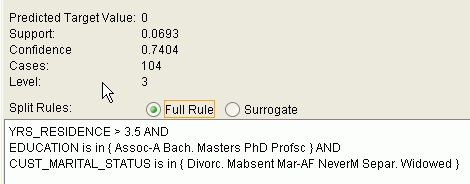Decision Tree Rules
Decision Tree generates rules that provide transparency, helping validate models by showing the basis for predictions.
Oracle Machine Learning supports several algorithms that provide rules. In addition to decision trees, clustering algorithms provide rules that describe the conditions shared by the members of a cluster, and association rules provide rules that describe associations between attributes.
Rules provide model transparency, a window on the inner workings of the model. Rules show the basis for the model's predictions. Oracle Machine Learning supports a high level of model transparency. While some algorithms provide rules, all algorithms provide model details. You can examine model details to determine how the algorithm handles the attributes internally, including transformations and reverse transformations. Transparency is discussed in the context of data preparation and in the context of model building in Oracle Machine Learning for SQL User’s Guide.
The following figure shows a rule generated by a Decision Tree model. This rule comes from a decision tree that predicts the probability that customers increase spending if given a loyalty card. A target value of 0 means not likely to increase spending; 1 means likely to increase spending.
The rule shown in the figure represents the conditional statement:
IF
(current residence > 3.5 and has college degree and is single)
THEN
predicted target value = 0
This rule is a full rule. A surrogate rule is a related attribute that can be used at apply time if the attribute needed for the split is missing.
